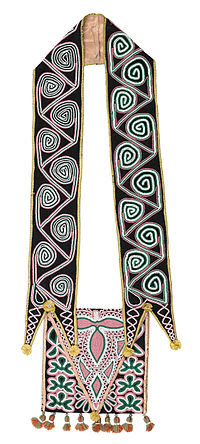Creek (American Indians)

Muscogee Creek bandolier bag, c. 1820, Birmingham Museum of Art
|
|
| Total population | |
|---|---|
| (2010: self-identified 88,332 alone and in combination) | |
| Regions with significant populations | |
|
|
|
| Languages | |
| English, Muscogee, and Hitchiti-Mikasuki | |
| Religion | |
| Protestantism, Four Mothers Society, and others | |
| Related ethnic groups | |
| Muskogean peoples: Alabama, Koasati, Miccosukee, Chickasaw, Choctaw, and Seminole |
The Muscogee, also known as the Creek and the Creek Confederacy, are a closely related group of native North American tribes or Indigenous peoples of the Southeastern Woodlands.Mvskoke (English: /məˈskoʊdʒi/; Mvskoke [maskóːkî]) is their autonym. They are originally from a single confederated native land that now comprises southern Tennessee, all of Alabama, western Georgia and part of northern Florida,
Most of the original population of the Muscogee people were forcibly relocated from their native lands in the 1830s during the Trail of Tears to Indian Territory (now Oklahoma). Some Muscogee fled European encroachment in 1797 and 1804 to establish two small tribal territories that continue to exist today in Louisiana and Texas. Another small branch of the Creek Confederacy managed to remain in Alabama and is now known as the Poarch Band of Creek Indians.
A much larger population of Creeks moved into Florida between roughly 1767 and 1821 and these people organized into a new confederacy called the Seminole Indian Nation, thereby establishing a separate identity from the Creek Confederacy. Muskogean (Creek) people in these waves of migration into Florida were fleeing conflict in Creek Confederacy lands, as well as encroachment by European settlers. The great majority of Seminoles were also later forcibly relocated to Oklahoma, where they reside today, although small branches of the nation remain in Florida.
...
Wikipedia
